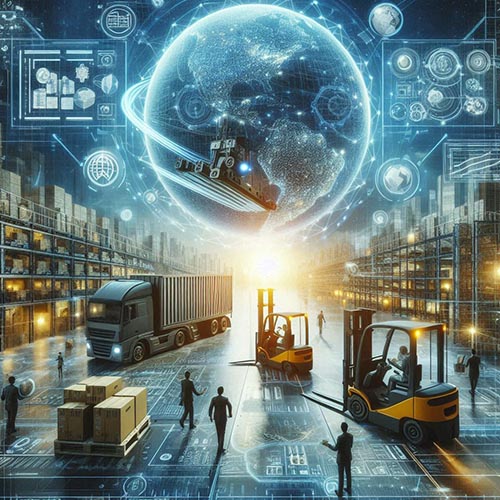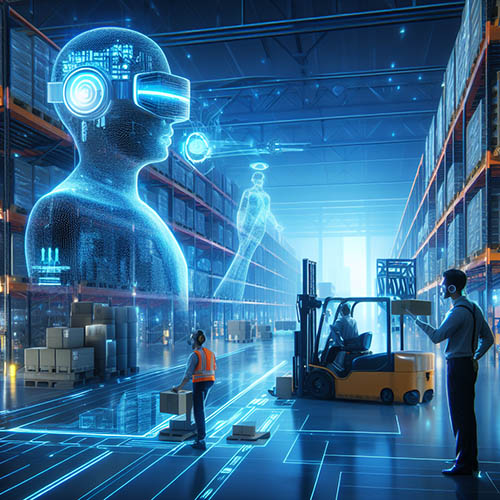Revolutionizing Material Handling: The Future of Efficiency
The material handling industry is on the verge of a transformation, driven by cutting-edge technologies like robotics, artificial intelligence, and IoT. From automated guided vehicles (AGVs) that streamline warehouse logistics to AI-powered analytics optimizing inventory management, businesses that adopt these innovations are poised to stay ahead of the competition. Whether you’re looking to reduce costs or enhance operational efficiency, these emerging technologies are reshaping the future of material handling, ensuring faster, smarter, and safer processes. Explore how these advancements can give your business the competitive edge it needs.
1. Robotics and Automation
One of the most significant technological advancements in material handling is the increasing use of robotics and automation. Automated Guided Vehicles (AGVs), Autonomous Mobile Robots (AMRs), and robotic arms are transforming the way goods are transported and managed within warehouses. These robots can efficiently handle repetitive tasks, such as picking, packing, and sorting, without human intervention.
- AGVs and AMRs: These are now widely used in large distribution centers for transporting goods across the facility. AGVs typically follow set paths, while AMRs are more flexible, using sensors and AI to navigate and avoid obstacles.
- Robotic Picking Systems: Advanced robotic picking systems can identify and handle different types of products with speed and precision. This technology significantly reduces the need for manual labor and minimizes human error in warehouses, enhancing productivity.
2. Artificial Intelligence (AI) and Machine Learning
AI is reshaping the landscape of material handling services by enabling smarter decision-making and predictive analytics. Machine learning algorithms can analyze massive datasets in real-time, allowing companies to optimize inventory management, predict demand, and streamline logistics operations.
- Predictive Maintenance: AI-driven predictive maintenance is being used to monitor equipment health in real-time. By predicting when a machine is likely to fail, companies can proactively schedule maintenance, reducing downtime and extending the life of equipment.
- Demand Forecasting: AI-powered analytics can help forecast demand patterns, enabling businesses to optimize inventory levels and reduce overstock or stockouts, thereby improving operational efficiency.
3. Internet of Things (IoT) and Smart Sensors
The Internet of Things (IoT) plays a crucial role in making warehouses smarter and more efficient. IoT-enabled sensors can provide real-time visibility into the status of goods, equipment, and operations.
- Asset Tracking: Smart sensors and RFID tags enable real-time tracking of inventory and equipment, providing data that can be used for better inventory management, reducing loss and ensuring that goods are handled correctly.
- Environmental Monitoring: IoT sensors can monitor environmental conditions such as temperature, humidity, and vibrations to ensure sensitive materials are stored and transported under optimal conditions.
4. Warehouse Management Systems (WMS)
A Warehouse Management System (WMS) is a software solution that helps businesses manage their warehouse operations more efficiently. Modern WMS solutions integrate seamlessly with other systems, such as Enterprise Resource Planning (ERP) software, to provide end-to-end visibility and control over inventory, order fulfillment, and labor management.
- Real-Time Data Integration: Modern WMS solutions offer real-time data analytics and reporting, enabling warehouse managers to make informed decisions quickly.
- Automation Integration: Advanced WMS systems can integrate with automation technologies like robotics, AGVs, and conveyor systems, optimizing the flow of goods and reducing labor costs.
5. Augmented Reality (AR) and Virtual Reality (VR)
AR and VR technologies are emerging as useful tools in material handling, particularly in training and operational efficiency. These technologies are increasingly being used in warehouse management for tasks such as inventory picking and worker training.
- AR in Picking: AR glasses or handheld devices can guide workers through the warehouse, showing them the exact location of products and providing real-time instructions, reducing picking errors.
- VR for Training: Virtual reality can simulate warehouse environments, enabling workers to practice tasks like forklift driving or machine operation in a safe and controlled environment before handling actual equipment.
6. Drones and Aerial Systems
Drones are being adopted for a variety of tasks in material handling, particularly for inventory management in large warehouses and distribution centers. They can be equipped with sensors and cameras to scan barcodes and RFID tags, making inventory checks faster and more accurate.
- Inventory Management: Drones can quickly navigate large warehouses to scan inventory, saving significant time and labor costs.
- Surveillance and Monitoring: Drones are also being used for facility surveillance, ensuring security and safety in large warehouse spaces.
Conclusion
The material handling industry is evolving rapidly with the adoption of emerging technologies. From robotics and AI to IoT and drones, these innovations are helping companies improve efficiency, reduce costs, and enhance safety. As these technologies continue to advance, businesses that invest in them will be better positioned to meet the demands of a fast-paced and ever-changing market.
For companies looking to stay competitive, now is the time to explore these cutting-edge solutions and integrate them into their material handling operations.
Browse Quantum Storage Products
Learn More About Material Handling Products



